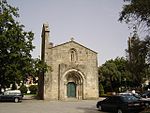Cedofeita, Santo Ildefonso, Sé, Miragaia, São Nicolau e Vitória
Parishes of PortoPorto geography stubs
Cedofeita, Santo Ildefonso, Sé, Miragaia, São Nicolau e Vitória is a civil parish in the municipality of Porto, Portugal. It was formed in 2013 by the merger of the former parishes Cedofeita, Santo Ildefonso, Sé, Miragaia, São Nicolau and Vitória. The population in 2011 was 40,440, in an area of 5.43 km². It covers the historic part of the city of Porto.
Excerpt from the Wikipedia article Cedofeita, Santo Ildefonso, Sé, Miragaia, São Nicolau e Vitória (License: CC BY-SA 3.0, Authors).Cedofeita, Santo Ildefonso, Sé, Miragaia, São Nicolau e Vitória
Rua Augusto Luso, Porto Cedofeita (Cedofeita, Santo Ildefonso, Sé, Miragaia, São Nicolau e Vitória)
Geographical coordinates (GPS) Address Nearby Places Show on map
Geographical coordinates (GPS)
| Latitude | Longitude |
|---|---|
| N 41.156 ° | E -8.623 ° |
Address
Rua Augusto Luso
Rua Augusto Luso
4050-072 Porto, Cedofeita (Cedofeita, Santo Ildefonso, Sé, Miragaia, São Nicolau e Vitória)
Portugal
Open on Google Maps









